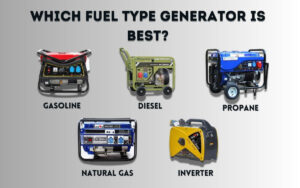how to reduce generator vibration?
Generators are essential equipment in many industries and applications, providing critical power backup and ensuring operational continuity. However, a common problem with generator operation is excessive vibration. In the short term, excessive vibration can lead to increased noise pollution, potentially disrupting the work environment and violating local noise ordinances. More seriously, it can cause premature wear, waste fuel, and reduced power output.
In this blog post, MATCHUP will study the causes, diagnosis and various vibration reduction ways of generator vibration, such as proper mounting, balancing, isolation, regular maintenance, etc. Whether you are an experienced technician or a generator owner, this guide will provide actionable insights to improve the durability and performance of your generator.

Understanding generator vibration
What is generator vibration? Generator vibration refers to the oscillatory motion that a generator experiences during operation. A range of factors can cause this motion and manifest as shaking of the generator and its components, rattling, increased component wear, and abnormal vibration readings on monitoring equipment.
Causes of generator vibration
Generator vibration can come from a variety of sources, which can be broadly categorized as mechanical, electrical, and external.
Mechanical causes
- Imbalanced rotating components (rotors, crankshafts): Even slight imbalances can cause excessive vibration at high speeds, which can lead to component wear. Common causes include manufacturing defects or long-term damage.
- Misaligned couplings, bearings, and other drive components: This can be caused by improper installation or movement of components over time. Misalignment can cause increased stress on bearings and other elements, leading to vibration and failure.
- Worn bearings or gears: As the generator ages, these components wear out. Worn components may not function properly, leading to increased vibration.
- Loose foundation or mounting bolts: The generator must be mounted on a solid and level foundation. An unstable or poorly prepared foundation can cause excessive vibration in the generator. Inadequate mounting or support can also lead to vibration problems.
Electrical causes
- Unbalanced electrical loads: Asymmetrical power consumption creates an uneven magnetic field.
- Generator winding faults: Damaged or degraded windings change the magnetic field distribution.
- Electromagnetic forces: Irregular magnetic fields can cause stator or rotor vibrations.
- Loose stator windings or laminations: They vibrate due to electromagnetic forces.
External factors:
- Environmental vibrations (e.g., nearby mechanical resonances or when the natural frequency of a component matches the operating frequency of the generator, earthquakes)
- Fluctuations in fuel supply or quality (for engine-driven generators)
- Extreme temperatures affect material properties
Diagnosing generator vibrations
Accurate diagnosis is essential for effective vibration reduction. Here is a systematic approach:
Preliminary inspection:
- Visual inspection to watch for unusual movement, cracks or loose parts
- Listen for unusual sounds: unusual whines, rattles or pops may indicate a specific problem
- Check for signs of wear, such as metal shavings or overheating
Tools and instruments:
- Vibration analyzers: measure vibration amplitude, frequency and phase
- Permanent vibration sensors: Permanent vibration sensors are installed on the generator to monitor the vibration level continuously. They can alert you to unusual vibrations in real time, allowing immediate action.
- Accelerometers: detect vibrations in a specific direction
- Spectrum analyzers: break vibrations down into frequency components for detailed analysis
- Stroboscopes: help visualize components that rotate at high speeds
- Laser alignment Tools: for precise coupling and shaft alignment checks
Vibration data is typically expressed in amplitude and frequency, which describes the range and speed of vibration. High amplitude readings or abnormal frequencies may indicate a vibration problem. If the vibration readings are consistently high or you cannot identify the cause of the unusual vibration, consult a professional for further analysis and repair.
Other diagnostic techniques:
Thermal imaging to detect hot spots: Identify areas of excessive friction or electrical issues
- Oil analysis to detect wear debris: Can reveal internal component degradation
- Motor current signature analysis: Detect electrical imbalance and some mechanical issues
- Ultrasonic testing: Identify bearing issues and some electrical problems early
- Operational data logging: Track performance metrics over time to identify trends
Ways to reduce generator vibration
Effective management of generator vibration is critical to maintaining performance, extending equipment life, and ensuring safe operation. Here are several proven ways to reduce generator vibration:
Balancing
Static balancing is used when the generator is stationary to ensure that the rotating components are evenly balanced and not affected by dynamic forces. This can be done using static balancing equipment and techniques, such as adding or removing weights to achieve balance. Dynamic balancing involves adjusting the rotating components of the generator to ensure they are evenly distributed. This reduces the forces that cause vibration and ensures smooth operation. Regular dynamic balancing helps maintain optimal performance and reduce vibration.
Alignment
Proper alignment of all rotating components is critical to preventing vibration. Improper alignment can cause increased vibration and uneven component wear. Use alignment tools such as dial indicators, laser alignment systems, or rulers to ensure proper alignment. Ensure proper alignment of the generator with the prime mover (such as an engine or turbine), as well as alignment of bearings, gears, and other drive components. Finally, make regular alignment checks part of your maintenance program
Replacement
Timely replacement prevents further vibration problems and maintains generator performance. Replace worn bearings, gears, or other components with high-quality components that have tight tolerances. Timely replacement prevents further vibration problems and maintains generator performance. In addition to original parts, you may also consider upgrading to more vibration-resistant parts where applicable, and ensure proper installation and run-in procedures for new parts. Follow the manufacturer’s maintenance and replacement interval recommendations and monitor performance after replacement to confirm improvement.
Use high-quality vibration isolation materials
Different vibration isolation methods, such as vibration isolation pads, flexible brackets, and spring isolators, are selected based on the weight of the generator, operating conditions, and the required level of vibration reduction. Applying damping compounds between the metal parts of the generator can also reduce resonance.
Vibration isolation pads are a material designed to absorb and reduce vibration transmitted from the generator to the surrounding structure. Made of rubber, neoprene, or polyurethane, these pads help reduce the effects of vibration and prevent damage to the foundation and nearby equipment.
Spring isolators are particularly useful for heavy generators or generators with higher vibration levels. They use springs to absorb and isolate vibrations, thereby reducing vibration transmitted to the base or foundation. Use spring isolators if you experience persistent vibration problems that cannot be solved by other methods. When installing, ensure that the spring isolators are sized correctly and refer to the manufacturer’s guidance. Periodic inspection and adjustment may be required to maintain effectiveness.
Foundation
Mount the generator on a stable and level foundation and make sure the foundation can support the weight of the generator and meets specifications. Common foundation types include concrete slabs and steel platforms. Concrete foundations are better for durability and stability, while steel platforms can be used where flexibility and adjustment are required. You will also need reinforcement depending on the weight and dynamic loads of the generator. You may also consider using rubber or neoprene isolation pads between the generator and the foundation. If you notice any signs of foundation instability, such as cracks or shifting, address these issues immediately to prevent vibration problems.
Electrical load balancing
Ensure that the electrical load on each phase is balanced. You can implement an automatic load balancing system for dynamic environments or use a power quality analyzer to identify and correct load imbalances.
Implement a comprehensive maintenance plan
Follow the maintenance schedule provided by the generator manufacturer, such as every 500 to 1000 hours of operation or as per the manufacturer’s maintenance schedule. Routine maintenance tasks include tightening bolts and fasteners to specified torque values, checking belts and bearings, and cleaning and lubricating moving parts.
Regular inspections can help identify early signs of vibration problems, such as loose parts, worn parts, or alignment issues. Develop an inspection program that includes visual inspections, component testing, and vibration measurements. Routine inspections can prevent more serious problems and extend the life of the generator.
Other considerations:
- Avoid resonance: Identify and modify natural frequencies consistent with operating speed
- Environmental controls: Manage ambient temperature and humidity to maintain consistent operating conditions
- In complex cases or for large industrial generators, consulting a vibration expert can provide valuable expertise and ensure the best results.
Conclusion
From reduced efficiency and increased wear to potentially catastrophic failure, the consequences of uncontrolled vibration can be severe. However, with the right knowledge and techniques, this challenge can be effectively managed and overcome.
Remember, vibration management is not a one-time fix, but an ongoing process. Ongoing monitoring and regular maintenance are essential to detect potential issues early and maintain optimal performance.
While the technologies we have discussed can significantly improve the performance of any generator, why not start with a generator designed for minimal vibration? At MATCHUP, we take generator vibration reduction very seriously, incorporating advanced design features and quality components into every generator we produce.
Our latest range of generators features:
- Precision balanced rotors using balancing technology
- Advanced isolation systems to minimize vibration transfer
- Premium bearing and gear designs for smooth, quiet operation
- Sturdy generator frame to resist bending and resonance
- Smart load balancing system for consistent, stable output
- User-friendly interface for easy monitoring and maintenance
Contact us today to learn about our vibration-optimized generators.


May Ge
Outdoor Machinery Export Manager 6-Yr Exp 🌍 ∣ BSCI, EPA, EURO V, CE ∣ Generator, High-pressure Washer, Water Pump, Engine, Floor Scrubber ∣ 🚀 24/7 Second Reply
TAIZHOU BISON MACHINERY CO.,LTD | Ningbo University of Technology
Our related blog

Can you use a regular generator for welding?
MATCHUP will explore the technical requirements of a welding power source, what regular generators can actually handle, and help you understand the difference between them.

Which fuel type is best for generators?
This article is designed to guide you in choosing the right generator fuel type for your specific needs. By exploring the pros and cons of each fuel, we’ll help you make the best decision.

What are the main components of a generator?
MATCHUP will introduce the main components of a generator, how they work together, and their role in efficient power generation.

winterizing your portable generator
Below is a complete guide to winterizing your portable generator. It contains all the tips and tricks you need to know. Keep reading to learn more.







